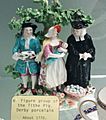Tithe facts for kids
A tithe is like giving a tenth part of something you have, usually your money or crops, to a religious group. It's often seen as a tax, a payment for services, or a voluntary gift. The idea of tithing comes from ancient times, mentioned in the Book of Numbers in the Bible.
In ancient Israel, the tribes of Levites were the priests. They didn't own land in Canaan like the other tribes. So, the other tribes gave them tithes. This helped support the Levites and their religious work. Tithes could be money, crops, or other valuable things.
Contents
What is a Tithe?
A tithe means "a tenth part." It's a payment made to a religious organization. This payment is usually a tenth of a person's income or what they produce.
Why People Pay Tithes
People pay tithes for different reasons.
- It can be seen as a tax that helps support the religious group.
- Sometimes, it's like a fee for the services the religious group provides.
- For many, it's a voluntary gift to show their faith and support their community.
Tithes in Ancient Laws
In ancient times, many cultures had systems similar to tithes.
The Laws of Moses
Under the Laws of Moses in ancient Israel, people were asked to give a tenth of their crops and animals to the priests. These priests then had to give a tenth of what they received as an offering to God. These tithes were usually paid once a year. This system helped support the religious leaders and their work.
Tithes in Europe
Tithes were very common in Europe for many centuries.
Tithes in France
Before the French Revolution (which started in 1789), the Roman Catholic Church in France collected tithes. These tithes were like taxes. They were mainly paid by the common people, known as the Third Estate. This group made up about 98% of France's population.
The tithes were taxes on land owned by members of the Third Estate. This meant that even if you were a farmer, you had to give a part of your harvest to the Church. After the French Revolution, a new Constitution was created in 1791. This new Constitution officially ended the practice of collecting tithes in France.
Images for kids
-
A collection bag used in the Lutheran Church of Sweden to collect a portion of ones' tithes during the offertory
-
Elmsett tithe memorial in Suffolk, England opposite the parish church, protesting against a tithe seizure
-
Knights Templar tithe barn (la grange aux dîmes) with red roof, Coulommiers, Seine-et-Marne, France
-
Casa de los Diezmos, Canillas de Aceituno, Málaga, Spain
-
Part of an 1842 tithe map including the small village of East Dundry near Bristol, England with names of its fields and two farms. Note the tithe-officer signature and stamp near the top.
-
The Tithe Barn, Abbotsbury, Dorset (scene of the sheep-shearing in Thomas Hardy's Far from the Madding Crowd)
-
Coggeshall near Braintree, Essex; the timber has been dated to between 1130 and 1270.
See also
 In Spanish: Diezmo para niños
In Spanish: Diezmo para niños













